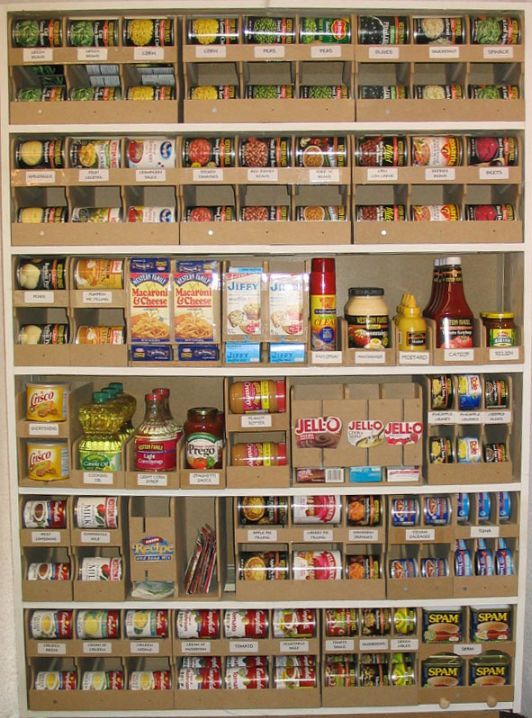“Deception is a state of mind and the mind of the state.” – James J. Angelton (A former chief of CIA Counterintelligence)
- Ad SIEGE belt: the original unmatched action belt. Proven in many unexpected situations on wearers' daily routines & travels. Engineered for extreme durability, performance, comfort & stunning looks. The only effective EDC you can take anywhere.SIEGE STOVES: prep for adventure/crisis with the ultimate ultra-compact survival stove. SIEGE BELTS: prized by those in the know. Blazing fast. Stunning appearance. USA-made.
- Ad Trekker Water Station 1Gal Per MinuteCall us if you have Questions 800-627-3809
Preparedness Notes for Monday – January 08, 2018
On this day, in 1835, the U.S. National Debt reached zero for the first and only time. This is also the birthday of the late Algis Budrys (born 1931, died June 9, 2008). He was the Lithuanian-American science fiction author who wrote the classic survivalist novel Some Will Not Die.
- Ad LifeSaver 20K JerryCan Water PurifierThe best water jerrycan you can buy on the market! Mention Survivalblog for a Free Filter ($130 Value)
- Ad USA Berkey Water Filters - Start Drinking Purified Water Today!#1 Trusted Gravity Water Purification System! Start Drinking Purified Water now with a Berkey water filtration system. Find systems, replacement filters, parts and more here.
Remington TAC-14 Shotgun, by Pat Cascio
By request, from our own Jim Rawles, we are taking a close look at the Remington TAC-14 shotgun.
Unique in Barrel Length
Something a little unique about the Remington TAC-14 shotgun is the barrel length of only 14 inches. Normally, this would be considered an NFA firearm and you’d have to jump through all the red tape and hoops in order to own one. However, Remington cleverly got around this in a number of ways. First of all, there is the overall length of 26.3-inches. Secondly, the very unique Raptor Pistol Grip gives the TAC-14 the much needed few more inches so this isn’t considered a “sawed-off shotgun” that we’ve all heard about.
Shotgun For Home Defense
I used to advocate a short barrel (18 inch) shotgun as the ultimate in home defense, and that is still true, in a few cases, but it’s not the best choice. When I was teaching SWAT techniques to small police departments, they all had “riot shotguns”. And when trying to maneuver through narrow hallways in a house or a business, the shotgun proved cumbersome and hard to work with. It was not quite what you want when a threat is around every corner or in every room. Next time, try taking your home-defense shotgun through your house and walking through narrow hallways or small rooms. See just how fast you can bring the shotgun up and ready to fire, and you’ll see what I’m talking about.
- Ad STRATEGIC RELOCATION REALTYFOR SALE: Self-sustaining Rural Property situated meticulously in serene locales distant from densely populated sanctuary cities. Remember…HISTORY Favors the PREPARED!
- Ad Click Here --> Civil Defense ManualNOW BACK IN STOCK How to protect, you, your family, friends and neighborhood in coming times of civil unrest… and much more!
Recipe of the Week: Down East Corn Chowder, by S.V.
Ingredients:
- 3 cups of fresh corn, cut from cob (or 2 16oz cans of whole kernel corn, drained)
- 2 medium potatoes, peeled and finely chopped
- 1 onion, finely chopped
- 1 tsp salt
- 1/2 tsp seasoned salt
- 1/8 tsp pepper
- 2 cups chicken broth or bouillon
- 2 cups milk
- 1/4 cup butter or margarine
- Ground mace
Continue reading“Recipe of the Week: Down East Corn Chowder, by S.V.”
- Ad Ready Made Resources, Trijicon Hunter Mk2$2000 off MSRP, Brand New in the case
- Ad California Legal Rifles & Pistols!WBT makes all popular rifles compliant for your restrictive state. Choose from a wide range of top brands made compliant for your state.
Economics & Investing For Preppers
Here are the latest items and commentary on current economics news, market trends, stocks, investing opportunities, and the precious metals markets. We also cover hedges, derivatives, and obscura. And it bears mention that most of these items are from the “tangibles heavy” contrarian perspective of JWR. (SurvivalBlog’s Founder and Senior Editor.) Today’s focus is on investing in silver half dollars.
Precious Metals:
Gold & Silver Are More Relevant Than Bitcoin – DeCarley Trading
o o o
Precious Metals Price Predictions for 2018
o o o
And here is a contrarian prediction, from the UK: Commodities Outlook: Gold Price to Fall in 2018. “A maturing Chinese economy will hurt demand for commodities such as aluminum and iron ore. Gold’s prospects are mixed.”
- Ad Civil Defense ManualClick Here --> The Civil Defense Manual... The A to Z of survival. Looks what's in it... https://civildefensemanual.com/whats-in-the-civil-defense-manual/
- Ad USA Berkey Water Filters - Start Drinking Purified Water Today!#1 Trusted Gravity Water Purification System! Start Drinking Purified Water now with a Berkey water filtration system. Find systems, replacement filters, parts and more here.
The Editors’ Quote of the Day:
“In the second article, it is declared, that a well regulated militia is necessary to a free state; a proposition from which few will dissent. Although in actual war, in the services of regular troops are confessedly more valuable; yet while peace prevails, and in the commencement of a war before a regular force can be raised, the militia form the palladium of the country. They are ready to repel invasion, to suppress insurrection, and preserve the good order and peace of government. That they should be well regulated, is judiciously added. A disorderly militia is disgraceful to itself, and dangerous not to the enemy, but to its own country. The duty of the state government is, to adopt such regulation as will tend to make good soldiers with the least interruptions of the ordinary and useful occupations of civil life. In this all the Union has a strong and visible interest.” – William Rawle, “A View of the Constitution of the United States of America” (1829)
- Ad Survival RealtyFind your secure and sustainable home. The leading marketplace for rural, remote, and off-grid properties worldwide. Affordable ads. No commissions are charged!
- Add Your Link Here
Preparedness Notes for Sunday – January 07, 2018
This is the birthday of several notables: Senator Rand Paul (born 1963); Cresson Kearny (born 1914, died December 18, 2003); and Bent Faurschou-Hviid, known as The Flame (born 1921, died October 18, 1944). The Flame was a red-haired Danish resistance fighter in the Holger Danske Group during World War II. His exploits were dramatized in the movie Flame and Citron.
o o o
SurvivalBlog Writing Contest
Today features another entry for Round 74 of the SurvivalBlog non-fiction writing contest. The nearly $11,000 worth of prizes for this round include:
First Prize:
- A $3000 gift certificate towards a Sol-Ark Solar Generator from Veteran owned Portable Solar LLC. The only EMP Hardened Solar Generator System available to the public.
- A Gunsite Academy Three Day Course Certificate. This can be used for any one, two, or three day course (a $1,095 value),
- A course certificate from onPoint Tactical for the prize winner’s choice of three-day civilian courses, excluding those restricted for military or government teams. Three day onPoint courses normally cost $795,
- DRD Tactical is providing a 5.56 NATO QD Billet upper. These have hammer forged, chrome-lined barrels and a hard case, to go with your own AR lower. It will allow any standard AR-type rifle to have a quick change barrel. This can be assembled in less than one minute without the use of any tools. It also provides a compact carry capability in a hard case or in 3-day pack (an $1,100 value),
- Two cases of Mountain House freeze-dried assorted entrees in #10 cans, courtesy of Ready Made Resources (a $350 value),
- A $250 gift certificate good for any product from Sunflower Ammo,
- Two cases of Meals, Ready to Eat (MREs), courtesy of CampingSurvival.com (a $180 value), and
- American Gunsmithing Institute (AGI) is providing a $300 certificate good towards any of their DVD training courses.
Second Prize:
- A Model 175 Series Solar Generator provided by Quantum Harvest LLC (a $439 value),
- A Glock form factor SIRT laser training pistol and a SIRT AR-15/M4 Laser Training Bolt, courtesy of Next Level Training, which have a combined retail value of $589,
- A gift certificate for any two or three-day class from Max Velocity Tactical (a $600 value),
- A transferable certificate for a two-day Ultimate Bug Out Course from Florida Firearms Training (a $400 value),
- A Trekker IV™ Four-Person Emergency Kit from Emergency Essentials (a $250 value),
- A $200 gift certificate good towards any books published by PrepperPress.com,
- RepackBox is providing a $300 gift certificate to their site.
Third Prize:
- A Royal Berkey water filter, courtesy of Directive 21 (a $275 value),
- A large handmade clothes drying rack, a washboard, and a Homesteading for Beginners DVD, all courtesy of The Homestead Store, with a combined value of $206,
- Expanded sets of both washable feminine pads and liners, donated by Naturally Cozy (a $185 retail value),
- Two Super Survival Pack seed collections, a $150 value, courtesy of Seed for Security, LLC,
- Mayflower Trading is donating a $200 gift certificate for homesteading appliances, and
- Two 1,000-foot spools of full mil-spec U.S.-made 750 paracord (in-stock colors only) from www.TOUGHGRID.com (a $240 value).
Round 74 ends on January 31st, so get busy writing and e-mail us your entry. Remember that there is a 1,500-word minimum, and that articles on practical “how to” skills for survival have an advantage in the judging.
2018– The Decisive Year, by R.M.
It is my wholehearted opinion that the year 2018 will become the decisive year for the future of life on this planet. Culminating in an all-out nuclear war at worst, or ground war at best. Things as they stand are untenable for much longer. I am not advocating one position or plan over the other with this brief writing and I am not stating that violence or harming others should be considered. I am merely offering a wide variety of situations and possibilities to bring about different thoughts and ideas.
Long Gone is Political Leaders’ Desire to Promote Public Good
Long gone is integrity, honor, and a desire to promote the public good from political leadership, only to be replaced by self-serving hucksters hell bent on regime change, wars, and U.S. hegemony over the entire world. In most cases, the whole purpose of our “prepping” is in anticipation of events caused by this mindless leadership that will ultimately lead to societal breakdown and an “every man for himself” attitude. Unfortunately, while we prepare, others do not. The question for preppers becomes, can we realistically hold down the fort and protect what is ours in an onslaught of humanity bent on taking what we have at all costs?
Letter: Stocking Up on Toiletries
Hugh,
Just an FYI for those who like to stockpile toiletries: My husband is a big fan of the Old Spice Swagger products, and this time of year I go buy the “gift packs” for 50% off. That is a large body wash, body spray (that hubby uses for deo), and a deo stick. I drop about $50 and get enough body wash, shampoo, and spray for a year for him. Then this is the kicker, he doesn’t like the deo sticks, so come garage sale season, I sell those off at $2 a pop to thrilled folks. That makes my investment $3 per box, or $3 for a body spray and body wash. Those retail everyday for about $3-4 each. – K.A.
The Survivalist’s Odds ‘n Sods:
SurvivalBlog presents another edition of The Survivalist’s Odds ‘n Sods— a collection of news bits and pieces that are relevant to the modern survivalist and prepper from “HJL”. Frustrations abound in the land of the fleeced.
Hunting ISIS
It took the Philippines’ military over five months to drive ISIS out of Marawi and the devastation left nearly 300,000 as refugees with a destroyed city. Now the military is working with surrounding countries and changing how they deal with ISIS. They are on the offensive and they are recruiting civilians to their cause as militia: We Follow A New Force Hunting For Terrorists In The Philippines. (video ~8min)
Land of the Fleeced
Home of the Slave – Idiots in City Hall. Reader H.L. sent in this article about a couple in Florida that built themselves a multilevel tree-house getaway for only $30,000. They have now spent several times that in legal fees after local authorities informed them they had received a complaint and ordered them to remove it. A Florida court rubber stamped a ruling imposed by the City of Holmes Beach without any evidence of independent consideration and won’t even allow them to take it to the community for a vote of acceptance. They have appealed to the Supreme Court, but it is unlikely that they will get heard.
The Editors’ Quote of the Day:
“And when he was full forty years old, it came into his heart to visit his brethren the children of Israel. And seeing one of them suffer wrong, he defended him, and avenged him that was oppressed, and smote the Egyptian: for he supposed his brethren would have understood how that God by his hand would deliver them: but they understood not. And the next day he shewed himself unto them as they strove, and would have set them at one again, saying, Sirs, ye are brethren; why do ye wrong one to another? But he that did his neighbour wrong thrust him away, saying, Who made thee a ruler and a judge over us? Wilt thou kill me, as thou diddest the Egyptian yesterday? Then fled Moses at this saying, and was a stranger in the land of Madian, where he begat two sons.” – Acts 7:23-29 (KJV)
Preparedness Notes for Saturday – January 06, 2018
Today is the birthday of musician Earl Scruggs, (1924-2012) and British comic actor Rowan Atkinson (born 1955).
o o o
SurvivalBlog Writing Contest
This has been another entry for Round 74 of the SurvivalBlog non-fiction writing contest. The nearly $11,000 worth of prizes for this round include:
First Prize:
- A $3000 gift certificate towards a Sol-Ark Solar Generator from Veteran owned Portable Solar LLC. The only EMP Hardened Solar Generator System available to the public.
- A Gunsite Academy Three Day Course Certificate. This can be used for any one, two, or three day course (a $1,095 value),
- A course certificate from onPoint Tactical for the prize winner’s choice of three-day civilian courses, excluding those restricted for military or government teams. Three day onPoint courses normally cost $795,
- DRD Tactical is providing a 5.56 NATO QD Billet upper. These have hammer forged, chrome-lined barrels and a hard case, to go with your own AR lower. It will allow any standard AR-type rifle to have a quick change barrel. This can be assembled in less than one minute without the use of any tools. It also provides a compact carry capability in a hard case or in 3-day pack (an $1,100 value),
- Two cases of Mountain House freeze-dried assorted entrees in #10 cans, courtesy of Ready Made Resources (a $350 value),
- A $250 gift certificate good for any product from Sunflower Ammo,
- Two cases of Meals, Ready to Eat (MREs), courtesy of CampingSurvival.com (a $180 value), and
- American Gunsmithing Institute (AGI) is providing a $300 certificate good towards any of their DVD training courses.
Second Prize:
- A Model 175 Series Solar Generator provided by Quantum Harvest LLC (a $439 value),
- A Glock form factor SIRT laser training pistol and a SIRT AR-15/M4 Laser Training Bolt, courtesy of Next Level Training, which have a combined retail value of $589,
- A gift certificate for any two or three-day class from Max Velocity Tactical (a $600 value),
- A transferable certificate for a two-day Ultimate Bug Out Course from Florida Firearms Training (a $400 value),
- A Trekker IV™ Four-Person Emergency Kit from Emergency Essentials (a $250 value),
- A $200 gift certificate good towards any books published by PrepperPress.com,
- RepackBox is providing a $300 gift certificate to their site.
Third Prize:
- A Royal Berkey water filter, courtesy of Directive 21 (a $275 value),
- A large handmade clothes drying rack, a washboard, and a Homesteading for Beginners DVD, all courtesy of The Homestead Store, with a combined value of $206,
- Expanded sets of both washable feminine pads and liners, donated by Naturally Cozy (a $185 retail value),
- Two Super Survival Pack seed collections, a $150 value, courtesy of Seed for Security, LLC,
- Mayflower Trading is donating a $200 gift certificate for homesteading appliances, and
- Two 1,000-foot spools of full mil-spec U.S.-made 750 paracord (in-stock colors only) from www.TOUGHGRID.com (a $240 value).
Round 74 ends on January 31st, so get busy writing and e-mail us your entry. Remember that there is a 1,500-word minimum, and that articles on practical “how to” skills for survival have an advantage in the judging.
Making a Storehouse Moths Can’t Eat Away, by RAD
There is no time like the present to start storing up sustenance for that “just in case” scenario. In these uncertain times, when civil unrest can explode at the drop of an offensive phrase and natural disasters can strike at any moment, not to mention the threats of terrorism and possibility of war, it is a good time to ask yourself some questions. Are you prepared to withstand days, weeks, or even months without a source of food or water? Do you understand what could happen if, let’s say, a power grid is destroyed? Do you know how long a human being can survive without oxygen, food, or water? Well, read on and you will learn the answers to those questions, as well as some basic information about how to prepare a storehouse that the moths cannot eat away!
How Long Can A Human Survive Without Basics
First and foremost, let’s answer the question, “How long can a human being survive without air, food, or water?” An excellent way to remember the answer to this question is to memorize the following: “3/3/3 rule”. It’s explanation is that a human being can survive without:
- Air for up to three minutes,
- Water for up to three days, and
- Food for up to three weeks.
Continue reading“Making a Storehouse Moths Can’t Eat Away, by RAD”
The Editors’ Preps for the Week
To be prepared for a crisis, every Prepper must establish goals and make long-term and short-term plans. Steadily, we work on meeting our prepping goals. In this column, the SurvivalBlog editors review their week’s prep activities. They also often share their planned prep activities for the coming week. These range from healthcare and gear purchases to gardening, property improvements, and food storage. This is something akin to our Retreat Owner Profiles, but written incrementally and in detail, throughout the year. We always welcome you to share your own successes and wisdom in the Comments. Let’s keep busy and be ready!
JWR
Jim Begins:
Dear SurvivalBlog Readers,
We are still in Snow Shovel Mode, here at the ranch. We have three feet of snow on the ground.
The snow is so deep that one of our yearling steer calves jumped the fence, and was found wandering around our barnyard–even though there was no source of feed for him on that side of the fence. We just muttered our usual comment: “Bovine Delinquents!” Putting him back in the pasture took 20 minutes of shoveling to get him through a gate. As we used to say in the Army: ‘That was real. And that was fun. But that wasn’t real fun.”
The Survivalist’s Odds ‘n Sods:
SurvivalBlog presents another edition of The Survivalist’s Odds ‘n Sods— a collection of news bits and pieces that are relevant to the modern survivalist and prepper, this week from JWR. Today we highlight the population density of the Great Basin region.
Survival and Austere Medicine Book Update!
A group of medical professionals has rewritten their great Survival and Austere Medicine freeware book. The Second Edition was published in 2005 as a free PDF and has been download more than 5,000 times and it is found in many on-line prepper/survivalist collections. They have just released the Third Edition.
The new edition of the book remains free – it is a labor of love from a group of medically-orientated preppers and Survivalists – several MDs, nurses, Physician’s Assistants (PAs), a veterinarian, and a biomedical technician. Most of them live in Australia and New Zealand. The Third Edition (of December, 2017) is a complete update of the 2005 edition. There are many more chapters and nearly all of the original ones have been rewritten. It has been expanded from 250 pages to just over 600 pages! You can download the Third Edition free of charge, here.
o o o
Retreat Perimeter Security
“Max Velocity” recently posted this wisdom, over at his blog: Perimeter Security: Use of an Obstacle Plan. Here is a key quote: “It is essential to understand that any perimeter security measure that you use will only ever cause delay, by slowing down the ingress of an intruder. It is unlikely that you will be able to install a perimeter security feature that will permanently deny entry to a determined intruder, given sufficient time and determination. This is why in a military sense, any obstacle that is installed should be ‘covered by observation and fire.’ The obstacle is thus simply intended to delay the enemy, in order to be able to bring fire on them, the delay providing time in which to deploy forces to respond, thus regaining the initiative.”
o o o















